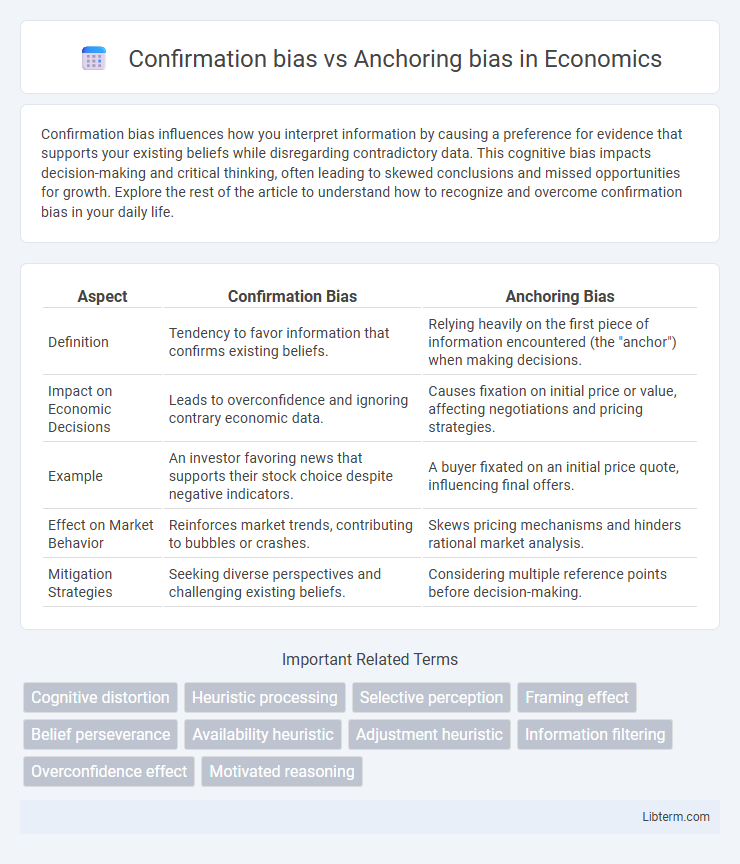Confirmation bias influences how you interpret information by causing a preference for evidence that supports your existing beliefs while disregarding contradictory data. This cognitive bias impacts decision-making and critical thinking, often leading to skewed conclusions and missed opportunities for growth. Explore the rest of the article to understand how to recognize and overcome confirmation bias in your daily life.
Table of Comparison
| Aspect | Confirmation Bias | Anchoring Bias |
|---|---|---|
| Definition | Tendency to favor information that confirms existing beliefs. | Relying heavily on the first piece of information encountered (the "anchor") when making decisions. |
| Impact on Economic Decisions | Leads to overconfidence and ignoring contrary economic data. | Causes fixation on initial price or value, affecting negotiations and pricing strategies. |
| Example | An investor favoring news that supports their stock choice despite negative indicators. | A buyer fixated on an initial price quote, influencing final offers. |
| Effect on Market Behavior | Reinforces market trends, contributing to bubbles or crashes. | Skews pricing mechanisms and hinders rational market analysis. |
| Mitigation Strategies | Seeking diverse perspectives and challenging existing beliefs. | Considering multiple reference points before decision-making. |
Introduction to Cognitive Biases
Cognitive biases are systematic patterns of deviation from norm or rationality in judgment, leading individuals to make illogical conclusions. Confirmation bias causes people to favor information that confirms their existing beliefs, while anchoring bias occurs when individuals rely heavily on the first piece of information encountered (the anchor) during decision-making. Both biases significantly impact reasoning processes and highlight the importance of awareness in critical thinking and decision analysis.
Defining Confirmation Bias
Confirmation bias is the tendency to search for, interpret, and remember information that confirms preexisting beliefs while ignoring contradictory evidence. Anchoring bias, in contrast, occurs when individuals rely too heavily on an initial piece of information when making decisions. Understanding confirmation bias is crucial for improving critical thinking and reducing cognitive distortions in decision-making processes.
Understanding Anchoring Bias
Anchoring bias occurs when individuals rely too heavily on an initial piece of information, or "anchor," when making decisions, often neglecting subsequent data that may be more relevant or accurate. This cognitive bias impacts judgment by skewing estimates and evaluations toward the anchor, leading to systematic errors in decision-making. Understanding anchoring bias is crucial for improving critical thinking and ensuring that decisions are based on comprehensive and updated information rather than initial impressions or irrelevant anchors.
Key Differences Between Confirmation and Anchoring Bias
Confirmation bias involves seeking, interpreting, and remembering information that confirms preexisting beliefs, while anchoring bias occurs when individuals rely too heavily on an initial piece of information (the anchor) to make subsequent judgments. Confirmation bias skews decision-making by reinforcing existing opinions, whereas anchoring bias distorts estimates and choices by fixating on the first available reference point. Understanding these distinctions helps in recognizing how cognitive biases differently influence reasoning and decision processes.
Psychological Mechanisms Behind Confirmation Bias
Confirmation bias arises from the psychological mechanism of selective information processing, where individuals prioritize data that aligns with their preexisting beliefs while disregarding contradictory evidence. This cognitive bias is driven by the brain's desire to reduce cognitive dissonance and maintain a coherent self-narrative, reinforcing existing attitudes and decisions. In contrast, anchoring bias involves relying heavily on an initial piece of information, or "anchor," which skews subsequent judgments, but confirmation bias fundamentally distorts information gathering and interpretation based on internal belief systems.
Psychological Mechanisms Behind Anchoring Bias
Anchoring bias arises from the psychological mechanism where initial information serves as a cognitive reference point, heavily influencing subsequent judgments and decisions. The brain's tendency to rely on the first piece of information encountered limits the adjustment process, often resulting in skewed estimates or predictions. This bias is rooted in heuristic processing and cognitive fixation, causing individuals to undervalue new evidence that contradicts the initial anchor.
Real-Life Examples of Confirmation Bias
Confirmation bias causes individuals to seek information that supports their preexisting beliefs, such as investors ignoring negative financial news to reinforce bullish market views. Anchoring bias occurs when people rely too heavily on the first piece of information encountered, like shoppers basing purchasing decisions on an initial price quote. Real-life examples of confirmation bias include medical professionals fixating on an initial diagnosis and disregarding contradictory test results, leading to misdiagnosis.
Real-Life Examples of Anchoring Bias
Anchoring bias occurs when individuals rely heavily on an initial piece of information when making decisions, such as when a shopper sees a high original price tag and perceives a discounted price as better value, even if the discount is minimal. Real-life examples include salary negotiations, where the first number proposed can set the tone for the entire discussion, or real estate pricing, where the initial listing price anchors buyers' perceptions of a home's worth. This cognitive bias can lead to suboptimal choices by limiting objective evaluation beyond the initial anchor.
Consequences of Both Biases in Decision-Making
Confirmation bias leads decision-makers to favor information that supports their preexisting beliefs, causing skewed evaluations and missed opportunities for better outcomes. Anchoring bias results in overreliance on initial information or reference points, which can distort judgment and lead to suboptimal decisions. Both biases reduce objectivity, increase the risk of errors, and limit effective problem-solving in critical decision-making processes.
Strategies to Overcome Confirmation and Anchoring Biases
Strategies to overcome confirmation bias include actively seeking out diverse viewpoints and challenging existing beliefs by reviewing contradictory evidence. For anchoring bias, recalibrating initial information through multiple reference points and delaying decision-making to gather more data reduce reliance on initial anchors. Employing critical thinking techniques and engaging in reflective judgment help mitigate both biases in decision-making processes.
Confirmation bias Infographic

 libterm.com
libterm.com